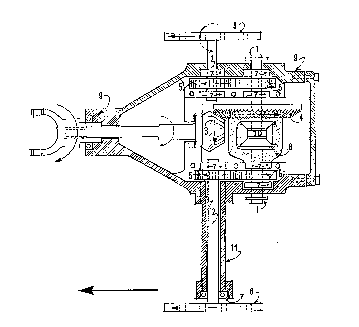Une partie des informations de ce site Web a été fournie par des sources externes. Le gouvernement du Canada n'assume aucune responsabilité concernant la précision, l'actualité ou la fiabilité des informations fournies par les sources externes. Les utilisateurs qui désirent employer cette information devraient consulter directement la source des informations. Le contenu fourni par les sources externes n'est pas assujetti aux exigences sur les langues officielles, la protection des renseignements personnels et l'accessibilité.
L'apparition de différences dans le texte et l'image des Revendications et de l'Abrégé dépend du moment auquel le document est publié. Les textes des Revendications et de l'Abrégé sont affichés :
| (12) Demande de brevet: | (11) CA 2227433 |
|---|---|
| (54) Titre français: | ENTRAINEMENT D'ESSIEUX TANDEM DES ROUES ARRIERE DE VEHICULES COMPACTS |
| (54) Titre anglais: | BACK WHEELS TWIN AXLES DRIVE SYSTEM FOR COMPACT VEHICLES |
| Statut: | Réputée abandonnée et au-delà du délai pour le rétablissement - en attente de la réponse à l’avis de communication rejetée |
| (51) Classification internationale des brevets (CIB): |
|
|---|---|
| (72) Inventeurs : |
|
| (73) Titulaires : |
|
| (71) Demandeurs : |
|
| (74) Agent: | |
| (74) Co-agent: | |
| (45) Délivré: | |
| (22) Date de dépôt: | 1998-03-19 |
| (41) Mise à la disponibilité du public: | 1999-09-19 |
| Licence disponible: | S.O. |
| Cédé au domaine public: | S.O. |
| (25) Langue des documents déposés: | Anglais |
| Traité de coopération en matière de brevets (PCT): | Non |
|---|
| (30) Données de priorité de la demande: | S.O. |
|---|
The new invention takes advantage of a dual axles drive system, on the rear
wheels traction of a vehicle, whereby the first axle the "back-up axle" is
powered to
turn in a backward direction which power is than transferred to the "wheels
drive
axle" located in front of the first axle, by means of transfer gears, one on
each
sections, that changes the backward direction of the first axle to a forward
wheels
drive on the second axle, gaining thru said combination, the advantage of a
downward theist of the drive pinion and driveshaft to which vehicle is
attached, thus
preventing the overturning of said vehicle when the wheels are blocked while
the
engine is running and clutch is not released in time as can happened in
conventional
one axle drive system of existing compact vehicles.
The object of this invention is to replace the single axle driving system,
presently used by an integrated twin axle driving system on rear wheels of
compact
vehicles such ase jeeps, farm tractors, or «A.T. V.» all terrain vehicle, in
order to
take advantage of a backward drive combine with a gears's system which can
prevent
the overturning of vehicles in certain instances.
Note : Les revendications sont présentées dans la langue officielle dans laquelle elles ont été soumises.
Désolé, les revendications concernant le document de brevet no 2227433 sont introuvables.
Les textes ne sont pas disponibles pour tous les documents de brevet. L'étendue des dates couvertes est disponible sur la section
Actualité de l'information
.
Note : Les descriptions sont présentées dans la langue officielle dans laquelle elles ont été soumises.

2024-08-01 : Dans le cadre de la transition vers les Brevets de nouvelle génération (BNG), la base de données sur les brevets canadiens (BDBC) contient désormais un Historique d'événement plus détaillé, qui reproduit le Journal des événements de notre nouvelle solution interne.
Veuillez noter que les événements débutant par « Inactive : » se réfèrent à des événements qui ne sont plus utilisés dans notre nouvelle solution interne.
Pour une meilleure compréhension de l'état de la demande ou brevet qui figure sur cette page, la rubrique Mise en garde , et les descriptions de Brevet , Historique d'événement , Taxes périodiques et Historique des paiements devraient être consultées.
| Description | Date |
|---|---|
| Inactive : CIB de MCD | 2006-03-12 |
| Demande non rétablie avant l'échéance | 2000-11-17 |
| Inactive : Morte - Demande incomplète | 2000-11-17 |
| Réputée abandonnée - omission de répondre à un avis sur les taxes pour le maintien en état | 2000-03-20 |
| Réputée abandonnée - omission de répondre à un avis exigeant une traduction | 1999-11-17 |
| Demande publiée (accessible au public) | 1999-09-19 |
| Inactive : Page couverture publiée | 1999-09-19 |
| Inactive : Incomplète | 1999-08-17 |
| Inactive : CIB en 1re position | 1998-06-13 |
| Symbole de classement modifié | 1998-06-13 |
| Inactive : CIB attribuée | 1998-05-25 |
| Inactive : Certificat de dépôt - Sans RE (Anglais) | 1998-04-16 |
| Demande reçue - nationale ordinaire | 1998-04-15 |
| Date d'abandonnement | Raison | Date de rétablissement |
|---|---|---|
| 2000-03-20 | ||
| 1999-11-17 |
| Type de taxes | Anniversaire | Échéance | Date payée |
|---|---|---|---|
| Taxe pour le dépôt - petite | 1998-03-19 |
Les titulaires actuels et antérieures au dossier sont affichés en ordre alphabétique.
| Titulaires actuels au dossier |
|---|
| MARCEL LEGARE |
| GILLES VILANDRE |
| Titulaires antérieures au dossier |
|---|
| S.O. |